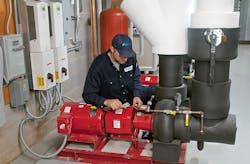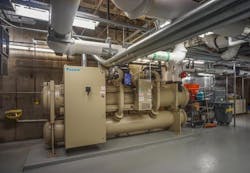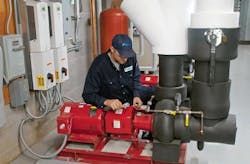Beyond the Flange: Maintaining Chiller Support Systems
While the chiller is the heart of chilled water systems, its support system of components and controls are equally critical to maintain and manage to ensure your system attains the highest efficiency levels.
Emphasis is often placed on the chiller since it is the most visible and higher energy element of a chilled water system. Yet, if you look beyond the flange, there’s an opportunity to improve delivery of cooling water to the airside or process loads and reduce unwanted heat to sources of heat rejection. There is a lot of low hanging fruit in maintenance – here are simple ways to save energy.
In large buildings and facilities, chilled water cooling systems can yield many advantages, including refrigerant and maintenance containment and energy efficiency. Those advantages can also be magnified when building owners
work with a partner to maintain the full system over the lifetime of a system to reap additional rewards. Look beyond the chiller itself to other components such as chilled and condenser water pumps, cooling towers, airside, and hydronic specialties including water pressure regulators, air separators, and chemical feed pots. Controls are also critical to the system because they operate water valves, control set points and schedule equipment.
Maintenance issues for the larger chiller system, including those at the component level, may indeed originate at the chiller. Yet, real detective work may be necessary to identify the root cause since trouble may start somewhere in the ancillary components of the chilled water system.
Water Pumps – In a typical chilled water system, the pump carries the warmer water from the air-side coils back to the chiller for re-cooling to 44F. Condenser water pumps deliver the 95° water rejected by the chiller to the cooling tower for cooling back down to 85F. Some tips for saving energy during this pumping process:
- Investigate putting VFDs on pumps
- Be sure the pressure settings are as low as possible
- Check the scheduling – is it on and off when it should be? This is one of the most common oversights and it uses a lot of energy. If the pumps are not running when the chiller is running, you will have a fault.
Common centrifugal impeller pump types include end-suction and split case construction. During servicing, consider pump and motor bearing lubrication and water seal cooling on larger pumps. Motor-pump shaft alignment is important and should be checked periodically as heavy piping and supports may shift over time. Providing positive suction pressure is important to prevent cavitation and air erosion. Cavitation can be caused when there is a change to lower the water pressure at the inlet of the pump. Pressure regulator stations maintain water loop pressure and air separators remove unwanted air from the chilled water.
Cooling towers – Condenser water transfers the unwanted heat load removed by the chiller and the chiller’s compressor work (heat of compression) to the cooling towers. These towers come in several common types: forced or induced draft and single and cross draft. Typically, towers are constructed of steel, fiber-glass reinforced plastic, wood or concrete. Service requirements across all types of cooling towers are consistent. Fan motors, gear drives, fan belts and water make-up float assemblies all require routine maintenance and inspection. It’s most important to check the operation and maintenance manual and recommended service schedules to cover proper maintenance. Tower basins as well as fill and distribution pans all need periodic cleaning.
Airside –This is where the heat load is transferred to the chilled water loop via a chilled water coil. Coils are part of an air handler unit, which also contains air filters, fans, mixing boxes/dampers, and other air handling devices. Coils are commonly constructed of copper tubes and aluminum fins requiring routine service such as air filter replacement and fin cleaning. Drain pans and lines also need to be cleaned of accumulated biological growth and dirt to sustain proper indoor air quality. Dirty coils can significantly curtail efficient heat transfer and hike energy use since operators typically must lower chilled water temperatures to overcome the reduction in heat transfer. A second negative consequence is increased fan energy with high air pressure drops.
Check fan operation, belt tightness, and VFD settings to be sure they match set points. Lots of energy can be wasted by running the VFDs at higher-than-necessary air pressure set points listed in the design documents.
Hydronic Specialties – Pressure water feed and relief stations should be checked periodically to ensure proper water loop pressure (as specified in your design documents). Pressure that’s too low may prevent circulation to high level air handler coils or cause pump cavitation. If the water is not getting to the air handlers on top of the building, you’ll see a drop in capacity. While they require minimal attention, a regular check of expansion tanks and air separators is wise. Chemical feed pots are used to introduce chemicals or glycol to closed loop systems. Heat exchangers need to be cleaned; it can be time consuming but the energy savings is worth the effort.
Water Treatment – Condenser water loops require treatment for the prevention and control of corrosion, scale presence, and biological growth. Closed chilled water system loops are not exposed to the atmosphere, but still need inhibiters to control corrosion. Open cooling tower systems are more demanding. Cooling towers act like a large air washer and require regular maintenance to combat corrosion problems. Many water treatment approaches are successfully used in systems today, including chemical, magnetic, and ozone types. Fouled water and scaled pipes inhibit heat transfer at the chiller and cooling coils. A miscue in water treatment can quickly damage the chiller’s tubes – a substantial and major performance issue. Therefore, regular eddy current testing of tubes is critical combined with consistent, effective water treatment. Because cooling towers evaporate large amounts of water with some drift to the atmosphere, control of biological matter is also an important health issue. Several antimicrobial growth products are available that will help minimize biological growth in the cooling tower basin.
Controls – New digital-based controls are fairly low maintenance other than occasional software updates and calibration. Older pneumatic systems employ air compressor/driers, which require specific routine service. While pneumatic systems are uncommon, moisture in a pneumatic system can be detrimental to proper operation causing expensive clean-up costs. Dampers and water control valves also should be checked for operation and lubed where necessary. Controlling the chiller plant pump sequence, air handler scheduling and exhaust fan operation can all impact chiller operation and performance. Chilled water temperature pull down rates need to be slow and steady. Fast temperature and/or flow changes can cause erratic and inefficient chiller operation. On variable flow systems, minimum flows should be confirmed. Check your operation and maintenance manuals for all settings.
Summary – The complexity of service tasks and frequency varies for all equipment and components; the manufacturers’ operation and maintenance manuals should be consulted for specific guidance. To sustain efficient and reliable operation, a building owner who relies on a chilled water system would benefit from a professional service technician’s advice and eye. Developing and executing a service schedule plan will help minimize unscheduled and costly shutdowns, while safeguarding the investment in equipment.
The extensive support system can often impact the chiller’s operation and the impacts are not always immediately apparent without digging deeper. The first step to operating a highly efficient chilled water system is understanding what’s installed, how it operates, and what is the right service plan approach to optimize over the full life of the equipment. Proper commissioning and establishing an energy baseline can also help in noting any service trends that require attention. Your best resource is an HVAC service provider that specializes in chilled water systems.
Joe Leichner, PE/CMVP is Director of Operations, Owner Sales, Daikin Applied Americas



